FARMER FIELD SCHOOL(FFS) - A VIEW
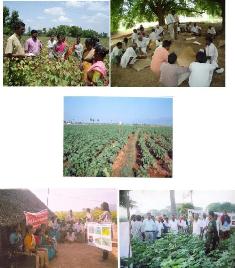
FFS IN TAMILNADU
FARMER FIELD SCHOOL - A VIEW
Introduction
If I hear it, I forget it. If I see it, I remember it If I discover it, I own it for life
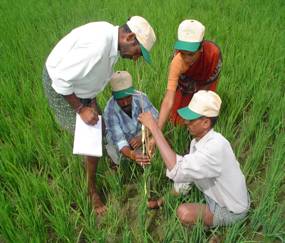
Farmer Field School (FFS) is non-formal educational activity.
All learning is a group activity and field based.
Empowers farmers to solve their field problems by themselves.
Fosters participation, interaction and joint decision making.
Farmers learn by carrying out activities through constant observation
The Farmer Field School is a form of adult education, which evolved from the concept that farmers learn optimally from field observation and experimentation. It was developed to help farmers tailor their Integrated Pest Management (IPM) practices to diverse and dynamic ecological conditions
In regular sessions from planting till harvest, groups of neighboring farmers observe and discuss dynamics of the crop’s ecosystem. Simple experimentation helps farmers further improve their understanding of functional relationships (e.g. pests-natural enemy population dynamics and crop damage-yield relationships). In this cyclical learning process, farmers develop the expertise that enables them to make their own crop management decisions. Special group activities encourage learning from peers, and strengthen communicative skills and group building.
IPM Farmer Field Schools were started in 1989 in Indonesia to reduce farmer reliance on pesticides in rice. Policy-makers and donors were impressed with the results and the program rapidly expanded. Follow-up training activities were added to enhance community-based activities and local program ownership. Eventually, IPM Farmer Field School programs for rice were carried out in twelve Asian countries and gradually branched out to vegetables, cotton and other crops. From the mid-nineties onwards, the experience generated in Asia was used to help initiate IPM Farmer Field School programs in other parts of the world. New commodities were added and local adaptation and institutionalization of these programs was encouraged. At present, IPM Farmer Field School programs, at various levels of development, are being conducted in over 30 countries worldwid
These diverse programs have generated a variety of data on the impact of the IPM Farmer Field School. Such data generally are presented in project reports that have a limited circulation. Impact studies that are published in official literature tend to focus on specific aspects of impact. Impact studies varied in focus, approach, methodology and robustness. Some lack description of methods. The nature of impact studies typically varies with the developmental stages of programs. Pilot projects often compared pesticide use and yields or profits of field plots grown with IPM practices and those under regular farmer practice, to demonstrate the merit of the approach. More advanced projects evaluated the adoption of IPM practices, studied expertise or recorded the developmental impacts resulting from farmer empowerment.
Top
Principles
-
“Grow a healthy crop” allows plants to recover better from environmental or pest injury, avoids nutrient deficiencies related with pest attack (insects and disease), and promotes natural defences to many insects and diseases inherent in plants. Proper crop and plant management methods used [Academic term: cultural controls].
-
“Conserve natural enemies” provides free biological control of insects and diseases. Parasites, predators and pathogens have long been recognised to control pest insects, but recent research shows microbial antagonists, and competitors of plant diseases are also important. Vertebrate natural enemies are also essential for control systems. Conservation usually implies avoiding inappropriate pesticide applications (herbicides, fungicides and insecticides all have impact on insect and disease natural enemies) or improving soil organic matter necessary for beneficial soil micro-organisms. Natural enemy habitat protection and development are more active methods of conserving natural enemies (e.g. owl houses, mulching for spiders, floral nectaries for parasites). Inoculation or inundation of reared natural enemies may be possible under special circumstances but usually only after conservation efforts have already been implemented. [Academic term: biological control].
-
“Observe crops regularly” means informed decision making for appropriate interventions to be made quickly for water, soil, and plant management. Inputs used are based on an ecologiceconomic assessment. [Academic term: Input analysis].
-
“Farmers become experts” in their own fields is crucial for long term management of soils, pests and crops. Expertise implies a basic understanding of the agro-ecological system, and decision making processes. Simple rules and directives may provide short term benefits but cannot sustain long term local developments.
Top
Basic Concepts
Doubtless there are many other programmes besides IPM field Schools which have succeeded to provide good educational results. Much of the field school ideas grew out of the traditions of literacy education and village-level basic health care. Similar programmes have been developed for soils, and livestock in other regions. The field Schools are not a new idea, just an effective idea that has been ignored by those caught in the system of top-down research message delivery and who too often turn a deaf hear to the conventional wisdom of farmers. Some farmer participants say that the IPM field Schools succeed because they provide basic scientific conceptual frameworks and knowledge in very democratically run field groups... and of course because farmers make more money with less inputs.
Below are basic concepts which are common to field Schools across many countries.
1. Adult non-formal education: Field Schools assume that farmers already have a wealth of experience, and knowledge. It also assumes that there may be misconceptions and bad habits learned during intensification programmes (e.g. little knowledge of natural enemies, basic fear of any insect that is seen in the field, etc.). Therefore the field Schools are oriented to providing basic agro-ecological knowledge and skills, but in a participatory manner so that farmer experience is integrated into the programme. For example, when observing in the field, facilitators will ask farmers what something is such as a natural enemy and ask who know what it might eat. Farmers give their response, and the facilitator adds his/her knowledge. If there is a disagreement between anyone, the facilitator and participants will set up simple studies to find the correct answer. In one field school farmers were discussing whether a certain lady beetle was a predator of pests or a pest of the plant. One farmer bet another on their choice. The facilitator showed how to put the lady beetle in a jars - one jar with pest prey and the other with leaves. The result was that the lady beetle ate the insects and the loser had to carry the winner around the village on his back! In fact there are both kinds of lady beetles but one type is ‘hairy’ and the other not. This was seen by the farmers.
2. Technically strong facilitator: The field school is usually initiated by an extension staff member of the government, farmers’ organization, or NGO. But in all cases the person must have certain skills. Most important is that the person is skilled at growing the crop concerned. In most countries, the extension staff have never grown crops ‘from seed to seed’ and most often lack confidence. For this reason, most IPM programmes have begun with training field staff in season-long courses which provide basic technical skills for growing and managing an IPM crop. Some people have called this the “Farmer respect course” in that field staff come to realise how difficult farming is, and why farmers do not immediately “adopt” their “extension messages”. Facilitation skills and group dynamic/group building methods are also included in this season to strengthen the education process in the field Schools. An uncertain trainer is a poor trainer. A confident trainer can say “I don’t know - let’s find out together” much easier when the inevitable unknown situation is encountered in the field.
3. Based on crop phenology and time limited: The field Schools and season long training for trainers are based on the crop phenology; seedling issues are studied during the seedling stage, fertiliser issues are discussed during high nutrient demand stages, and so on. This method allows to use the crop as a teacher, and to ensure that farmers can immediately use and practice what is being learned. Meeting on a weekly basis means that farmers are participating in a course for a whole season, but from an administrative/financial point of view, the same 40 hours as in an intensive one week programme. The educational benefits of meeting when problems are present (learner readiness), and on a recurrent basis have been studied and shown to be far more effective that intensive courses. Also the courses are delimited by the crop cycle. There is a definite beginning and end. The present system of many extension programmes of unending two week cycles removes focus, and excitement. field schools may extend beyond one season if groups agree, but rarely can be effective when less than the phenological cycle of the crop.
4. Group study: Most field Schools are organised for groups of about 25 persons with common interests can support each other, both with their individual experience and strengths, and to create a “critical mass”. As individuals, trying something new is often socially inappropriate (e.g. reducing sprays, cover crops), but with group support, trying something new becomes acceptable. The number of 25 is roughly the number that can comfortably work together with one facilitator. Usually these 25 are sub-divided into groups of five persons so that all members can better participate in field observations, analysis, discussion, and presentations.
5. Field School Site: The field Schools are always held in the community where farmers live so that they can easily attend weekly and maintain the field school studies. The extension officer travels to the site on the day of the field school
6. Building groups: One of the jobs of the facilitator is to assist the field school to develop as a support group so that participants can support one another after the field school is over. This is done by having elected officers (head, treasurer, and secretary), and group identity. The field school needs its own name - never the name of the founding organization! No hats, or shirts are given out. A budget may be prepared for this, but the group should make the design and have their own name on these. During the season, the field school includes group building exercises to build group trust and coherence. The field school may also include such activities as long-term planning (log frames), and proposal writing to find funding for activities groups decide to do together. Funding may come from a number of sources including from within the group itself, local shop owners, local governments, NGOs, or national programmes.
7. Basic science: Field Schools try to focus on basic processes through field observations, season-long research studies, hands-on activities. It has been found that when farmers have learned about basics, combined with their own experiences and needs, they make decisions that are effective. When farmers have this basic knowledge they are better clients for extension and research systems because they have more specific questions and demands. They also are able to hold these systems accountable for their output and benefits. And finally they are able to protect themselves from dubious sources.
8. Study fields [non-risk]: The field school has a small (usually about 1000 m2) field for group study. This is the core of the Field Schools. This field is essential for a field school because farmers can carry out studies without personal risk allowing them to take management decisions that they might not otherwise attempt in trials on their own farm. This provides farmers a way of testing a new method themselves before applying it to their own fields. It also allows for more interesting research topics such as defoliation simulations in which leaves are removed. The arrangement for this field varies based on local conditions. Some villages have communal lands that can be used for free, some villages may request on inputs, others areas may request compensation in case of lower yields in experiments, etc.. It is important to remember however that this land is to be maintained by the group - not by the facilitator alone - and is not a typical “demo-plot” as traditionally used in many programmes.
Top
Characteristics :
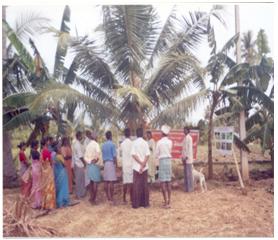
1. Farmers as Experts: Learning by doing is the training approach used. Farmers learn by carrying out for themselves the various activities related to the particular farming practice they want to study and learn about. This could be related to annual crops, livestock/fodder production, orchards or forest management. The key thing is that farmers conduct their own field studies. Their training is based on comparison studies (of different treatments) and field studies that they, not the extension/ research staff conduct. In so doing they become experts on the particular practice they are investigating.
2. The Field is the Primary Learning Material: All learning is based in the field. The field is where the farmers learn. Working in small sub-groups they collect data in the field, analyse the data, make action decisions based on their analyses of the data, and present their decisions to the other farmers in the field school for further discussion, questioning, and refinement.
3. Extension Workers as Facilitators Not Teachers: The role of the extension worker is very much that of a facilitator rather than a conventional teacher. Once the farmer know what it is they have to do, and what it is that they can observe in the field, the extension worker takes a back seat role, only offering help and guidance when asked to do so. Presentations during meetings are the work of the farmers not the extension worker, with the members of each working group assuming responsibility for presenting their findings in turn to their fellow farmers. The extension worker may take part in the subsequent discussion sessions but as a contributor, rather than leader, in arriving at an agreed consensus on what action needs to be taken at that time.
4. The curriculum is Integrated: The curriculum is integrated. Crop husbandry, animal husbandry, horticulture, silviculture, land husbandry are considered together with ecology, economics, sociology and education to form a holistic approach. Problems confronted in the field are the integrating principle.
5. Trainings Follows the Seasonal Cycle:Training is related to the seasonal cycle of the practice being investigated. For annual crops this would extend from land preparation to harvesting. For fodder production would include the dry season to evaluate the quantity and quality at a time of year when livestock feeds are commonly in short supply. For tree production and such conservation measures as hedgerows and grass strips training would need to continue over several years for farmers to be able to see for themselves the full range of costs and benefits.
6. Regular Group Meetings: Farmers meet at agreed regular intervals. For annual crops such meetings may be every 1 or 2 weeks during the cropping season. For other farm/forestry management practices the time between each meeting would depend on what specific activities need to be done, or be related to critical periods of the year when there are key issues to observe and discuss in the field.
7. Learning materials are learner generated: Farmers generate their own learning materials, from drawings of what they observe, to the field trials themselves. These materials are always consistent with local conditions, are less expensive to develop, are controlled by the learners and thus can be discussed by the learners with others. Learners know the meaning of the materials because they have created the materials.
8. Group dynamics/team building:Training includes communication skill building, problem solving, leadership, and discussion methods. Farmers require these skills. Successful activities at the community level require that farmers can apply effective leadership skills and have the ability to communicate their findings to others.
Top
Major Steps in FFS Implementation
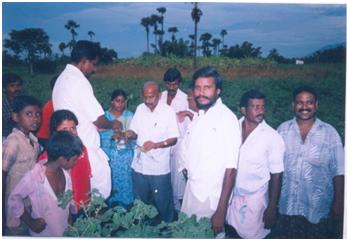
- Post FFS Regular follow up, backstopping
- Commercialization and marketing
- Networking and information sharing
- Season long FFS Activities 3-10 months cycle
- Farmers-led experimentation
- Backstopping
- Graduation
- Community Mobilization Ground working
- Formation of FFS groups
- Identification of host farm etc.
- Problem identification
- Training of trainers For extension workers or farmer trainers
- FFS methodology (2-4 weeks)
- Technical training (if needed)
Top
How FFS is Perceived?
-
A Paradigm Shift in Rural Development
-
An Approach for Empowering Farmers
-
A Form of Social Learning & Collective Action
-
A Space for Farmers To Learn
-
Operational Dimension of a Radically Different Way of Thinking
-
A form of adult education
-
A new form of extension
-
A religion
-
A new way to attract donor support
-
An insidious disease that threats certain interests
-
A new, manipulative transfer of Technology (TOT) too
Top
The Process of FFS
I. Organization and management
Duration : Usually 4-5 hours
Learning: Through sub-groups
Session management: Host teams
Leadership: Elected representatives
II. Agro Eco System Analysis(AESA)
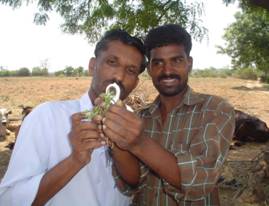 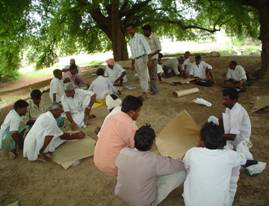
 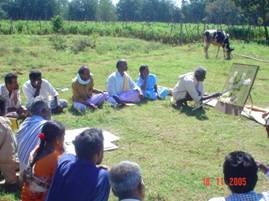
AESA is the cornerstone of FFS Approach. The purpose of using AESA is for farmers to learn to make regular field observations, analyze problems and opportunities encountered in the field and to improve decision-making skills regarding farm management. It helps farmers to make wise production management decisions, through analysis of relevant data collected from the field. By carrying out AESA regularly in the FFS, farmers develop a mental checklist of indicators to be observed when monitoring their farm practices.
AESA is a four-stage process
-
Field observation
-
Detailed the field observations on a presentation size paper
-
Presentations of results and conclusions/decisions by sub-groups
-
Whole group synthesis the preservations for collective implementation of the decisions arrived at.
III. Experimentation
Comparative studies
Field studies e.g. insect zoos, soil texture etc.
Long term or short term
IV. Group dynamics
To develop team building skills, organizational skills, cooperation, planning etc.
V. Special topics
Build on existing knowledge
Enable farmer interaction and sharing of information
Ensure demand lead information dissemination
Promote interaction between farmers, extension officers and scientists
VI. Typical FFS schedule
Time persons |
Activity |
Objectives |
Resp. |
8.00-8.10AM
|
Roll call, brief recap |
Know who is present. To remind ourselves of previous activities |
Host team
|
8.10-10.00AM |
AESA |
Analysis of the Agro-ecosystem all |
|
10.00-10.30AM
|
Group dynamics planning |
To energize (revitalize) the group
To enhance participation
To educate on group activities |
Host team/
facilitator |
10.30-11.30AM
|
Special topic
|
To input on a special topic which will widen scope of knowledge/ skills |
Facilitator
|
11.30-11.40AM
|
Review of the days activities |
To evaluate our achievements |
Facilitator
|
11.50-11.55AM
|
Role call
Announcements
absentees |
To note the late comers,
|
Host team
|
VII. FFS Graduation:
Occasion to recognize the time put in the FFS by the farmers and facilitators. Certificate awarded…….
Top
Training and Visit Comparision with Farmer Field School
| Point |
Classical Training and Visit |
Farmer Field School evolution |
Field-level extension officer’s job |
Deliver pre-packaged “messages” from a research-extension linkage. Primary job is information transfer, not technical expertise, which is reserved for Specialists not at the field level. |
Technical Facilitator: Every FFS trainer should have basic technical skills (at least able to grow the crop, or rear animals, etc.). Secondly, every FFS trainer should have group oriented training and management skills. These skills are typically learned in a season-long Training of Trainers where they learn what they will teach. |
Experience of trainers |
Variable, but most often lacking basic farming skills and experience. Field level staff given communication skills. |
Master trainer with farming experience gained during Training of Trainer programmes in which each person is required to grow crops and carry out field studies so that they test what they will use in Field Schools later. |
Information |
Primarily top-down messages from distant research stations about situations presumed to be representative of farms. |
Recommendations are tested against conventional practices and new information about to the site emerges. Promotes local creativity. |
Contact point |
Contact farmers that are supposed to train other farmers by passing on external information. |
Groups of interested farmers that farm on a daily basis through generating local study circles. |
Time frame |
Continuously, forever, on a two-week regular cycle not based on any natural phenology. |
A pre-defined period. Usually on a weekly basis over a season. FFS may be longer than a season, but never less than one season integrated with the crop phenology. |
Pedagogy |
Training: Use of static pre-determined demonstrations and in field examples to show and tell. |
Education: A focus on underlying principles that allow farmers to derive and adopt recommendations within their own dynamic their ecological, social, and economic realities. |
Evaluation |
At best indirect: based on measuring delivery and funds spent. |
Pre- and post-testing. Community self-surveying. Identifiable indicators defined in terms of system-critical factors. Internal rates of return. |
Training site |
Demonstration field, training centers, home of Contact Farmer, static not revisited in time or observed in terms of any on going process. |
A shared field in which the FFS uses to dynamically validate and test new management methods over the entire season (e.g. decisions during one part of the season can be verified by yield cuts) |
Long term objectives |
Increase food production, etc. “Farmer’s attitudes, lack of knowledge, and practices are an object/constraint of a development process” |
Nurture groups that will continue to address agricultural and community problems on their own and with technical backstopping.
“Farmers as the subject of development” |
Research |
Primary source of information is research stations assumed to develop representative models that are widely applicable. |
A process and consequence of local testing and within-community/ecosystem learning. |
Top
Limitation
-
Time consuming activity
-
Cost intensive process
-
Women involvement
-
It demands lot of preparations on the part of facilitators
-
Requires trained facilitators
-
Reach of farmers – A group of 20-25
-
Facilitator’s ability to enable farmers
Top
FARMER FIELDS SCHOOLS IN TAMILNADU
Introduction
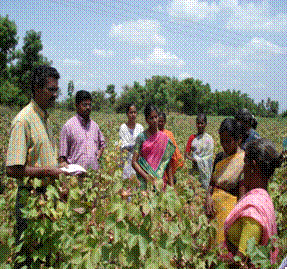
The term “Farmer Fields Schools” came from the Indonesian expression Sekolah Lapangan meaning just field school. The name Sekolah Lapangan was created to reflect the educational goals; the course took place in the field, and the field conditions defined most of the curriculum, but real field problems were observed, and analysed from planting of the crop (rice) to harvest. Group decisions on the crop management could be evaluated at the end of season by measuring the yield. A field was established by the participants with a research study to compare IPM methods and farmer’s conventional methods. Pre- and post-tests were given, the same farmers and facilitators attended throughout the season, and graduation was based on attendance and learning performance. Graduation certificates were awarded to farmers. Thus, the Field School was a school without walls that taught basic agro-ecology and management skills.
Almost one third of the world’s population are members of farming households in Asia. Most of these farming families are small holders. Forty years ago, the Green Revolution was launched with the aim of improving the productivity of small farmers. By improving access to water, improved varieties, and other inputs, the Green Revolution helped to double average rice yields between the 1960’s and the 1990’s.
During the 1970s it became increasingly apparent that pest resistance and resurgence caused by the indiscriminate use of insecticides posed an immediate threat to the gains of the Green Revolution. At the same time, research was being conducted that demonstrated the viability of biological control of major rice pests. However, gaps still existed between the science generated in research institutions and common farmer practice conditioned by years of aggressive promotion of pesticide use. Over the ensuing years, a number of approaches were tried to bring integrated pest management (IPM) to small farmers - particularly rice farmers - in Asia, with mixed results. Some experts claimed that the principles of IPM were too complex for small farmers to master, and that centrally-designed messages were still the only way to convince farmers to change their practices.
By the end of the 1980s, a new approach to farmer training emerged in Indonesia called the 'Farmer Field School' (FFS). The broad problem which these field schools were designed to address was a lack of knowledge among Asian farmers relating to agroecology, particularly the relationship between insect pests and beneficial insects
The implementation of projects using the FFS approach led to a deeper understanding of the problem and its causes. It was recognised that sustainable agricultural development required more than just the acquisition of ecological knowledge by individual farmers. It also required the development of a capability for generating, adapting and extending this knowledge within farming communities. The weakness of this capability in most farming communities is itself an important problem; one which has often been exacerbated by earlier agricultural development programmes that fostered a dependency on external sources of expertise.
This deeper understanding of the problem was first recognised by farmers in Indonesia who graduated from FFS but realised there was more they could do to improve rural livelihoods. They started to organise new groups, alliances, networks and associations, and became involved in planning and implementing their own interventions. These interventions were highly diverse, ranging from research and training, to marketing and advocacy work. In response to the activities of these groups, IPM projects started to support the idea of ‘Community IPM’, which gave considerable attention to organisational issues rather than focussing solely on technological and educational aspects of IPM
Indicative numbers from member countries of the FAO community IPM programme in Asia implementing IPM field schools (through 2000):
Country |
Year FFS began |
Rice FFS |
Farmers trained |
Other FFS* |
Farmers trained |
Farmer IPM trainers trained |
Bangladesh |
1994 |
5 490 |
141 470 |
373 |
9 410 |
679 |
Cambodia |
1996 |
670 |
20 000 |
85 |
2 500 |
254 |
China |
1993 |
1 306 |
37 877 |
13 |
390 |
1 817 |
Indonesia |
1989 |
37 429 |
935 152 |
6 388 |
159 600 |
29 522 |
India |
1994 |
6 302 |
189 683 |
- |
- |
- |
Laos |
1997 |
280 |
7 767 |
45 |
1 350 |
- |
Nepal |
1998 |
209 |
5 415 |
- |
- |
156 |
Philippines |
1993 |
6 000 |
180 000 |
1 200 |
336 000 |
- |
Sri Lanka |
1995 |
510 |
9 700 |
34 |
610 |
240 |
Thailand |
1998 |
525 |
12 027 |
- |
- |
- |
Viet Nam |
1992 |
19 876 |
515 927 |
1 993 |
55 098 |
6 178 |
An FFS initiative in Trichy area, Tamil Nadu, in 1997 helped farmers reduce their high input costs and increased the stability of cotton cropping systems through use of intercrops. Each FFS met for 23 sessions during the cropping season. They were able to eliminate chemical use in the IPM plots, compared with 8-10 applications in the FP plots, by using early sown cowpea as a border trap crop for pests, and castor to build up populations of beneficial insects. Farmers understood how the trap crop became a natural enemy breeding ground. Farmers had previously viewed pests from pulses as a problem, and used chemical applications on these crops. One of the major benefits of reducing the number of pesticide applications, apart from financial, was that women were saved hours of time previously spent hauling water from 3 km away for 10 applications by knapsack spraying. Since 60-70% FFS group members in cotton are women the benefits of reduced pesticides were very apparent.
Top
Model
-
FFS on Rice
-
FFS on Cotton
-
FFS on Maize
-
FFS on Oilseeds
-
FFS on Pulses
-
FFS on Vegetables
Top
Organisation Involved
-
State Agricultural University
-
Krishi Vigeyan kendra
-
ICAR Institute
-
Department of Agriculture
-
Cotton Corporation of India
-
Farmers Association
-
Non Govermental Organisation
-
Cooperatives
-
Private Sector
Through Tamil Nadu Agricultural University::
FFS on Cotton
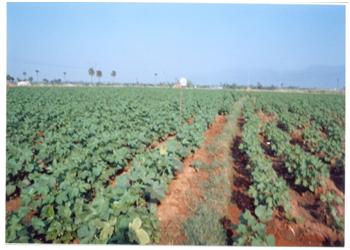
During the year 2005-06, 700 farmer field school were conducted in two season. In Kharif season 300 FFS at Coimbatore, Erode, Salem, Dharmapuri, Theni, Vellore, Dindogul, Perambalur and Villupuram district and 400 FFS in summer season at Dharmapuri, Krishnagiri, Salem, Madurai, Virudhunagar, Sivagangai, Ramnad, Tanjore, Thiruvarur and Nagapattinam distict.
During 2006-07, Winter season 200 FFS were conducted at Coimbatore, Salem, Preambalur, Dharmapuri and Vellore district and in summer season, 200 FFS were conducted in NAmakkal, Erode, Theni, Virudhunagar, Thirunelveli, Ramnad, Tanjore, Thiruvarur and Nagapattinam district.
Due to the implementation of this scheme awareness was created among the farmers. As a result the quantity of pesticides used by the farmers has been reduced which resulted in reducing the cost of production of otton. Due to te use of organic inputs also the pest load was reduced. With regard to the yield levels there was a different of 1-2 Q/acre between FFS and non FFS field i.e. the yield was increased to 1-2 Q under/acre. Farmers get 15-20% higher price than the market price.
Through Department of Agriculture
Integrated Pest Management (IPM) is a broad ecological pest control approach aiming at best mix of all known pest control measures to keep the pest population below economic threshold level (ETL). The major components in this approach are to advocate cultural, mechanical, biological and chemical control of insect pests, diseases, weeds and rodents. Therefore, a season long training will be given to the Agricultural Officers for important crops such as paddy, cotton, pulses and groundnut. For effective implementation of IPM, Farmers Field School has to be started.
Being the pioneering State in the country, the IPM concept has been well understood by the farmers especially through the Farmers Field School implemented in paddy and cotton . The object of this scheme is to maximise the production at a minimum cost and simultaneously obliviate the ill-effects like environmental pollution, pesticide residues in food, resurgence of pests etc. The IPM concept is being emphasised also through Centrally Sponsored Schemes like Integrated Cereals Development Programme (Rice), Accelerated Maize Development Programme, Oilseeds Production Programme, National Pulses Development Project and Cotton Mini Mission II. During 2001-2002, the following programmes have been implemented under IPM through Centrally Sponsored Schemes.
S.No. |
Name of the component |
Physical Programme |
Achievement. |
a |
IPM Demonstration -cum - training Cereals Development (Nos) |
1674 |
1386 |
b |
Farmers Field Schools under Cotton Mini – Mission II (Nos) |
40 |
40 |
c |
IPM Demonstration in pulses under NPDP (Ha) |
533 |
513 |
d |
IPM Demonstration under OPP (Ha) |
4000 |
3920.6 |
This approach is proposed to be continued during 2002-2003.
During 2004-05 the following programmes are implemented under IPM through Centrally Sponsored Schemes.
Sl. No. |
Name of the component |
Physical (Nos.) |
Programme |
Achievement
upto Feb 05 |
1 |
IPM- Demonstration cum FFS under Cereals Development Programme |
330 |
330 |
2 |
IPM Demo cum FFS under Cotton Mini-mission II |
350 |
340 |
3 |
IPM Demo cum FFS under ISOPOM maize |
16 |
16 |
4 |
IPM Demo (FFS) under ISOPOM - Oilseeds. |
66 |
65 |
5 |
IPM Demonstration under ISOPOM Pulses. |
25 |
24 |
This IPM approach will be continued during 2005-06 also.
IPM farmers field school in pulses
Farmers are trained for the adoption of IPM technology in field schools. 100 FFS have been organised to train farmers under IPM technology at a cost of Rs. 6.5 Lakhs in all districts except the Nilgiris The Integrated Pest Management Technology to combat pest and diseases was introduced in Tamilnadu through FAO Programme in late 80's and special thrust were laid to this concept through Farmers Field School approach. This season long training cum demonstration component involving 30 farmers in each training, created greater awareness among the farmers and being practiced in almost all the villages. Because of the large scale adoption of IPM technologies, the technical grade pesticide consumption which was annually around 10,000 MTs. a decade ago has come down to around 1300 MTs.
Through TNAU KVK
Farmers Field School on ‘SRI’
Farmer Field School Programme on Rice was conducted by KVK, Madurai in four villages namely Thindiyur Mettuneerathan, Mayandipatti and Kulamangalam of Madurai district. Participatory rural appraisal were carried out in these villages just before the cropping season i.e during June – July. Particularly transect walk was conducted by incorporating all stake holders such as farmers, extension officials, input dealers, agricultural scientists, NGOs and seed certification agencies. It was expressed by the farmers that the cost of production of rice is high and the productivity is low. Among the various measures discussed in the focal group discussion to reduce the cost of production and to increase the productivity led to the introduction of ‘SRI’ by the scientists.
After realizing the need among the farmers, technical deliberation on SRI was made through SRI modules and LCD projection through on and off campus training programmes. A special seminar on SRI was organized in which the subject matter specialist drawn from various pioneering institutes such as TRRI, Adudurai and AC&RI, Killiculam participated and clarified the doubts of the farmers. In addition to the technical knowledge, to give confidence and conviction the successful farmers who had already taken up SRI narrated their experiences
Subsequently as scheduled, mat nursery was raised in the farmers field in which only 7.5 Kg of seed per ha was used compared to 75 Kg / ha followed by the farmers. The critical input like certified seeds and biofertilisers are supplied to the individual farmers and cono weeders are given to the groups to encourage them in SRI practices.
Farmers were advised to go for line planting with the interval of 25 x 25 cm by using ropes. However they expressed that the planting of young single seedlings is a laborious act involving more labour than normal planting and sought technical guidance from the scientists to reduce the labour cost involved in the line sowing. In this regard a rolling marker developed by the KVK, Madurai for line sowing was taken up to the farmers field. Similarly farmers are also finding difficulties in operating cono weeder. Now the steps are being taken up to over come the constraints. The cost benefit analysis of SRI is also being worked out. Further to popularise this concept mass media programmes are being organized at periodical intervals.
Through NGO KVK-MYRADA
Farmers field school in cotton
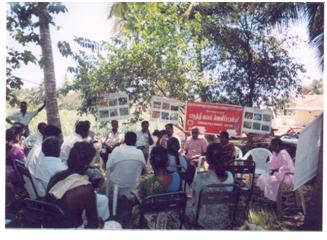
In 2008, FFS approach was conducted in Eangattuthottam, Pudhupalayam, Thaneerpandal and Chellampalayam of Andiyurblock of Erode district. 100 farmers from four villages were identified and 20 weekly sessions were held in various aspects of production and protection technologies. Through the implementations
-
Farmers were able to take the right crop management decisions at every stage of the crop
-
Farmers developed a regular habit of visiting their field and monitoring crop pest and diseases
-
Farmers quieres were cleared then and there by frequent contact between farmers and facilitators
-
Most of the farmers were able to differentiate the pests and defenders of cotton and realized the importance of conservation of natural enemies
-
Few indigenous technical knowledge which was of low cost and effective were recorded and the same was replicated in every individual FFS farmers field
-
Though controversises on pesticidal vs non pesticidal management of cotton production arose among the farmers, they ultimately accepted the concept of IPM technologies in cotton cultivation.
-
Group dynamics, participatory group presentation and discussion were a part of the programme. As a result, a sense of cooperation and team coordination developed amog the farmers which were helpful in spreding and sharing the technologies with each other.
Through Non Government Organisation
BEST
BEST is an NGO having its operational area at ”Keeranur‘ of Pudhukottai district, being member of SCINDeA, (a network NGOs promoting slum area and agriculture development work) have taken massive steps in popularizing the technology with the support from AME Foundation. In principle, it entered into an agreement with AME foundation for technical and partial fund support. It got trained its 30 staff members for 15 days period in SRI-Farmer Field School (SRI-FFS) mode and started its implementation in 15 villages through conducting SRI in FFS mode. During the field visit to their area while interacting with a woman farmer expressed SRI as good method to cultivate paddy as it has reduced the labour requirement, transplantation time, weed population etc.
AME Foundation
AME Foundation is a Non-Governmental resource organization. AME was born out of the concern for Sustainable Agriculture in 1982 in the Netherlands, and relocated in India in 1986. After being a project through several phases, it became an Indian organization, managed by a Board of Trustees, since 2002. AMEF is engaged in promoting livelihood improvements, of small and marginal farmers in Andhra Pradesh, Karnataka and Tamil Nadu by enabling them to generate and adopt alternative farming practices, through capacity building activities and by associating local development agencies.The objective is to enhance sharing, learning, networking and celebrating our bonding. The central purpose of these activities is to share with other agencies and policy makers the unique experiences, which AMEF has gained in promoting sustainability in dry land farming, and expand our contacts.
Contact Address:
TIRUCHI: No.37, E.V.R.Road, K.K. Nagar, Tiruchirapalli - 620 021,
Tamil Nadu. Ph: 0431 2458726 & 2455408 Fax (pp): 0431 2450725
try_ametry@sancharnet.in / ameftry@amefound.org
In Tiruchi, summer ploughing and bund repair were the main activities taken up on the field followed by input assessment and mobilisation by farmer federations. Twelve sessions of the Farmer Field School (FFS) in Brinjal were completed at Nochium village of Perambalur district
AME Foundation being in Dharmapuri district of Tamilnadu has been actively involved in promoting SRI paddy cultivation through offering Modified Training of Facilitators (MToF) in FFS mode keeping SRI as core. Joining hands with network NGOs like MYRADA in Krishnagiri, Hosur, Dharmapuri and SCINDeA at Yelagiri hills AME promotes SRI paddy through offering innovating trainings. In its recent training, offered SRI training in FFS mode by training the NGO staff members of 30 nos. from various parts of Tamilnadu and Pondicherry including CWS supported NGOs.
Ongoing Plan of FFS in Tamilnadu
National Food Security Mission(NFSM)
Rice
In Tamil Nadu, NFSM - Rice Scheme is implemented in five districts viz. Nagapattinam, Thiruvarur, Pudukottai, Ramanathapuram and Sivagangai from 2007-08 onwards to enhance the area and productivity of Rice. Interventions like farmers' training through Farmers' Field Schools and publicity are undertaken. Under this programme, it is aimed to increase the rice area and production in these districts from the present level of 6.077 Lakh ha to 6.920 Lakh ha and to enhance the rice production from 13.518 L.MT to 45.852 L.MT during 2011-12.
Pulses
The NFSM-Pulses scheme is implemented in 12 potential districts viz. Coimbatore, Cuddalore, Erode, Nagapattinam, Namakkal, Thiruvarur, Thiruvallur, Thoothukudi, Thiruvannamalai, Vellore, Villupuram and Virudhunagar. Under this scheme, incentives are extended for production and distribution of quality seeds, distribution of gypsum, micro nutrients, sprinkler sets, Integrated Pest Management Demonstration and Farmers Training. This scheme aims at to increase the pulses area from the present level of 4.32 L.ha to 7.36 L.ha during 2011-12 and to enhance the pulse production from 1.43L.MT to 4.78L MT. To increase the pulses production in Tamil Nadu by adoption of 2% DAP foliar spray twice and application of micro nutrients.
Sources::
http://www.encyclopedia.thefreedictionary.com
http://www.jsysindia.org
http://www.fao.org
http://www.farmerfieldschool.net
http://en.wikipedia.org./wiki/Farmer_Field_school
http://www.tnpolicynotes.com
Book: Participatory Impact monitoring and evaluation of agriculture and rural development programme- M.J.Chandra Gouda
Top |

